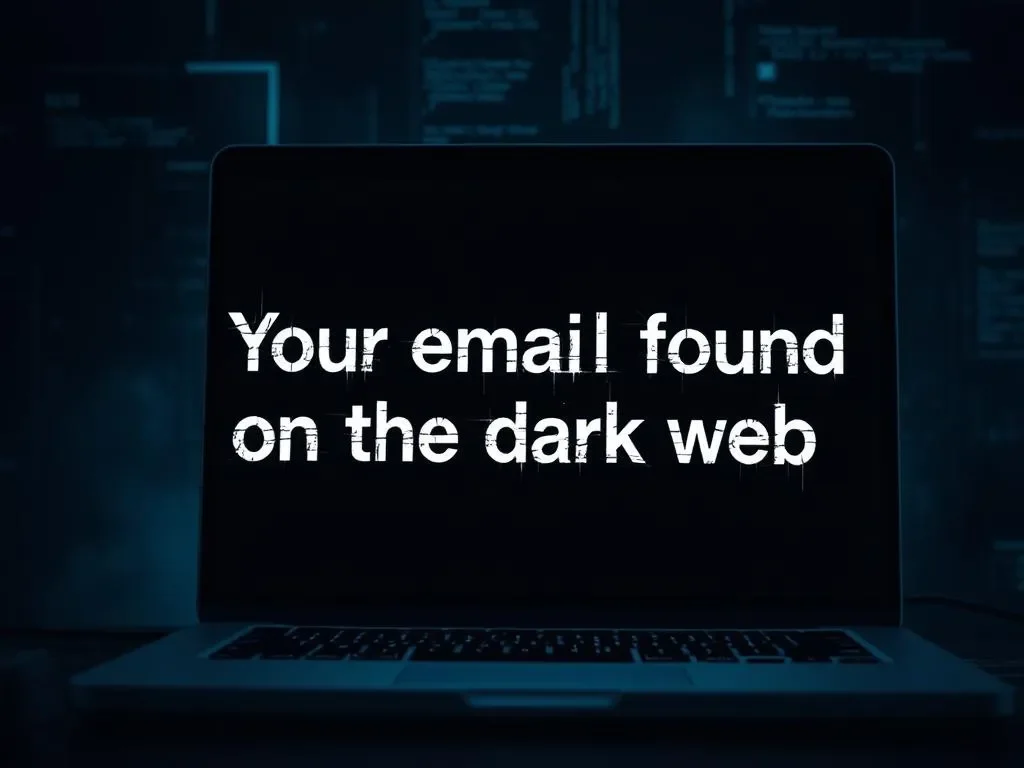My Email Was Found on the Dark Web – Here’s What to Do
What does it mean if my email is found on the dark web? Can I remove my email from the dark web? These were my questions when I found out. The feeling of being vulnerable was overwhelming, but I knew I had to act fast to protect myself.
My email on the dark web made me worry about my online security. What risks and consequences could it bring? This article will guide you if you’re in a similar situation.
Discovering my email on the dark web was a wake-up call. I knew I had to act quickly to protect myself. If you’re wondering about your email on the dark web, this article is for you.
Key Takeaways
- If my email was found on the dark web, it may be at risk of being used for malicious activities.
- What does it mean if my email is found on the dark web? It means my email has been compromised and is available on the dark web.
- Can I remove my email from the dark web? While it is difficult to completely remove my email from the dark web, I can take steps to protect my identity and secure my online accounts.
- My email was found on the dark web, and now I need to take action to protect myself from possible threats.
- What does it mean if email is found on the dark web? It means that my email has been exposed and is vulnerable to being used for malicious activities.
- I need to take immediate action to protect my identity and secure my online accounts if my email is found on the dark web.
Understanding Dark Web Email Exposure
When an email found on the dark web is discovered, it can be a cause for concern. The dark web is a part of the internet that is not indexed by search engines. It’s often linked to illegal activities. To grasp the impact of dark web email exposure, it’s key to understand how emails get there and the threats they pose.
The dark web is a complex network of websites and servers that use encryption to stay anonymous. Emails can land on the dark web through data breaches, phishing scams, and hacking. Once there, they can be used for identity theft, spam, and phishing attacks.
What the Dark Web Actually Is
The dark web is a small part of the deep web, which includes all websites not indexed by search engines. The dark web makes up only about 3% of the total internet traffic.
How Emails End Up on the Dark Web
Emails can end up on the dark web in several ways, including:
- Data breaches: When a company’s database is hacked, emails can be stolen and sold on the dark web.
- Phishing scams: Phishing emails can trick users into revealing their email passwords, which can then be used to access their accounts.
- Hacking: Hackers can gain access to email accounts by exploiting vulnerabilities in software or using malware.
Common Types of Email-Related Dark Web Threats
Some common types of email-related threats found on the dark web include:
- Phishing attacks: Scammers use emails to trick users into revealing sensitive information.
- Spam: Unsolicited emails are sent to promote products or services.
- Identity theft: Emails can be used to steal personal information and commit identity theft.
Immediate Steps After Finding Your Email on the Dark Web
Discovering your email on the dark web can be scary. But, it’s key to stay calm and act fast to lessen harm. If you find out what to do if your details are found on the dark web, start by changing passwords for all linked accounts.
Wondering should i be worried if my information is on the dark web? Knowing your email is there ups the risk of identity theft and fraud. To lower these risks, turn on two-factor authentication for your email and other key accounts.
To keep safe, watch your credit report and online accounts for anything odd. This means:
- Regularly checking your bank and credit card statements
- Setting up alerts for unusual transactions
- Keeping an eye on your credit score
By taking these steps right away, you can lessen the damage from your email being on the dark web. Always stay alert and keep an eye on your online life to protect your security and peace of mind.
| Step | Action |
|---|---|
| 1 | Change passwords for all associated accounts |
| 2 | Enable two-factor authentication |
| 3 | Monitor credit report and online accounts |
How to Verify if Your Email Was Actually Compromised
Discovering that my email was found on the dark web can be scary. It’s hard to know how bad it is. To figure out what to do, first check if your email was really hacked. If my email was found on the dark web but i don t know what to do, start by using dark web monitoring tools.
Using Dark Web Monitoring Tools
These tools can find if your email was hacked and tell you what to do next. You can also use Have I Been Pwned to see if your email is in any data breaches. If my email was found on the dark web android device, you’ll need to take extra steps to keep your account safe.
Checking Have I Been Pwned
This website is great for checking if your email was in a data breach. By searching for your email, you can see if it was hacked. Then, you can take steps to protect your account.
Professional Data Breach Search Services
For a deeper search, try professional data breach search services. They give detailed info on data breaches with your email. They also help you keep your account safe.
Change Your Passwords Right Now
After finding your email on the dark web, it’s key to change password after email leak. This step helps stop others from getting into your account. It also lowers the chance of identity theft and financial scams.
Make your passwords strong by mixing letters, numbers, and symbols. You can also use a password manager. It helps you keep track of your complex passwords easily.
Changing your passwords is just the start. You should also enable two-factor authentication for email. This adds an extra security layer. It asks for your password and a code sent to your phone or another device to log in.
Here’s what to do:
- Change your email password right away
- Turn on two-factor authentication for your email
- Use a password manager for unique and complex passwords
Setting Up Two-Factor Authentication for Protection
To add extra security to your online accounts, setting up two-factor authentication is key. This method needs a password and another form of verification, like a code sent to your phone or a biometric scan.
Using strong passwords is important, but it’s not enough. Two-factor authentication adds an extra layer against hackers and cyber threats. With a strong password and a second verification, you can greatly lower the risk of your account being hacked.
Best 2FA Apps to Use
Many two-factor authentication apps are available, like Google Authenticator and Authy. These apps create a unique code you must enter along with your password. This adds an extra layer of security.
Setting Up 2FA on Critical Accounts
Critical accounts, like email and banking, should have two-factor authentication turned on. This protects your sensitive info and stops unauthorized access.
Recovery Options and Backup Codes
It’s vital to have recovery options and backup codes ready. This way, if you lose access to your two-factor authentication, you can get back into your account. It prevents you from being locked out.
Monitoring Your Financial Accounts for Suspicious Activity
After finding your email on the dark web, it’s key to watch your financial accounts closely. This means setting up credit monitoring after data breach to keep an eye on your credit report. This way, you can spot identity theft early and act fast to reduce its harm.
To keep an eye on your accounts, follow these steps:
- Set up alerts for large or unusual transactions
- Regularly review your account statements and credit reports
- Report any suspicious activity to your bank or credit card company immediately
If you think identity theft has happened, report it to the authorities right away. This can stop more damage and help you get back on track. Always be careful and active in protecting your financial info to avoid identity theft and fraud.

My Email Was Found on the Dark Web – What Are the Risks?
Discovering your email on the dark web can be scary. It’s key to know the risks and protect yourself. If your email is on the dark web, it’s important to act fast.
Having your email on the dark web can lead to identity theft, financial fraud, and account takeovers. These threats can cause serious harm, like financial loss and damage to your credit score. It’s vital to understand these risks and take steps to protect yourself.
Identity Theft Possibilities
Identity theft is a big worry when your email is on the dark web. Hackers can get your personal info, like your name and social security number. They might use this to open new accounts or commit crimes in your name.
Financial Fraud Risks
Financial fraud is another danger. Hackers can get your bank and credit card details through your email. They might use this to make unauthorized transactions or drain your accounts.
Account Takeover Threats
Account takeovers are also a risk. Hackers can access your online accounts, like social media and email. This can lead to identity theft, financial fraud, and damage to your reputation.
To stay safe, you need to act quickly. Change your passwords, use two-factor authentication, and watch your accounts for any odd activity. These steps can help protect you from identity theft, financial fraud, and account takeovers.
| Risk | Description | Consequences |
|---|---|---|
| Identity Theft | Cybercriminals gain access to personal information | Financial loss, damage to credit score, emotional distress |
| Financial Fraud | Cybercriminals gain access to financial information | Unauthorized transactions, drained accounts, financial fraud |
| Account Takeover | Cybercriminals gain access to online accounts | Identity theft, financial fraud, reputational damage |
Reporting the Incident to Proper Authorities
When my email was found on the dark web, I knew I had to act fast. I had to protect myself from identity theft. Reporting identity theft to the authorities is key to prevent more harm. The Federal Trade Commission (FTC) and local police are the right places to report such incidents.
I found out that reporting identity theft to the authorities helps a lot. It’s important to give all the details you can. This includes your email address, when it happened, and any odd activities. Reporting it helps the police catch the bad guys and keeps others safe too.
To make my email safer, I started using a password manager for stronger security. It makes unique, hard-to-crack passwords for all my accounts. I also turned on two-factor authentication for even more safety.
Here are some good things about reporting the incident to the authorities:
- It stops more harm to my identity and money
- It helps the police find the bad guys
- It gives me tools to fix the problem

By doing these things, I made my email safer and protected myself from identity theft. Remember, telling the authorities and using a password manager are key steps. They help prevent more harm and keep your email safe.
Creating a Stronger Email Security System
To stop identity theft after an email breach, you need a strong email security system. If your email was hacked on the dark web, act fast to protect your online accounts. Start by using a password manager to create and keep unique, complex passwords for each account.
Password Manager Implementation
A password manager is key to stopping identity theft. It makes and keeps unique, complex passwords for all your accounts. This way, even if your email was hacked, your other accounts stay safe.
Email Encryption Options
Email encryption is vital for a strong email security system. It keeps your emails safe from unauthorized access, even if your email was hacked.
Security Questions Best Practices
Security questions add an extra layer of protection against identity theft. Use a mix of letters and numbers for your security questions. Avoid using your birthdate or common words that are easy to guess.
By following these tips and using a password manager, email encryption, and strong security questions, you can greatly lower the risk of identity theft. This helps protect your online accounts, even if your email was hacked on the dark web.
Prevention Steps for Future Protection
To keep your email and online accounts safe, it’s vital to take action. Use strong, unique passwords for each account. Also, enable two-factor authentication whenever you can.
Knowing how to remove my email from the dark web is also important. This helps prevent further misuse. Use dark web monitoring tools and services for cybersecurity for leaked emails.
Here are some key steps to prevent future breaches:
- Regularly update your software and operating systems to get the latest security patches.
- Use a reputable antivirus program to fight off malware and other threats.
- Be careful when clicking on links or opening attachments from unknown sources.
By following these steps and staying updated on cybersecurity for leaked emails threats, you can lower the risk of your email and online accounts being hacked. Remember, prevention is the best way to protect your digital identity and sensitive information.

When to Consider Professional Identity Protection Services
Discovering your email on the dark web can be scary. Taking quick action is key. One step is to look into identity theft protection services. These services add extra security and watch over your data, helping to lower risks from how hackers use stolen emails on the dark web.
When checking out identity theft protection services, know what they offer. Good services watch your personal and financial info all the time. They send alerts for anything odd and help fix identity theft problems.
It’s important to weigh the cost vs. benefit of these services. There’s a cost, but the benefits of keeping your identity and money safe are worth it. Being proactive and using identity theft protection services can greatly lower your risk of identity theft. This can save you from financial and emotional harm.
Conclusion: Staying Secure in a Digital World
Having your email exposed on the dark web can be very risky. It can lead to identity theft and financial fraud. But, you can take steps to protect yourself. Start by securing your online accounts and watching for any suspicious activity.
It’s also important to check Have I Been Pwned to see if your email has been hacked. Think about getting a professional identity protection service for extra safety.
In today’s world, being careful and keeping your digital life safe is key. Use a password manager and two-factor authentication. Also, keep an eye on your financial accounts.
By doing these things, you can protect your digital identity. And, if there’s a data breach, you’ll be ready. The most important thing is to stay informed and always be ready to protect your sensitive information.
FAQ
What does it mean if my email was found on the dark web?
If your email is on the dark web, it means hackers have your email and personal info. They might sell it online. This could lead to identity theft and other online dangers.
Can I remove my email from the dark web?
It’s hard to get your email off the dark web once it’s there. The best thing to do is protect your accounts and watch for any odd activity.
What should I do if my email was found on the dark web?
If your email is on the dark web, act fast. Change your email password and turn on two-factor authentication. Also, keep an eye on your money and credit reports for any odd signs.
Should I be worried if my information is on the dark web?
Yes, being on the dark web is a big worry. It could lead to identity theft and other online dangers. You need to act quickly to protect yourself.
How can I check if my email was actually found on the dark web?
Use tools like Have I Been Pwned to see if your email is on the dark web. You can also hire a service to check for you.
What are the risks of having my email on the dark web?
Being on the dark web can lead to identity theft and financial fraud. Hackers might use your info to steal your identity or money.
How can I prevent my email from being found on the dark web in the future?
To avoid dark web issues, use strong passwords and two-factor authentication. Be careful of phishing and use a password manager. Always check your accounts and credit report for odd activity.







I don’t think the title of your article matches the content lol. Just kidding, mainly because I had some doubts after reading the article.
Your point of view caught my eye and was very interesting. Thanks. I have a question for you.